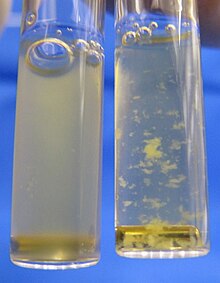Platelet aggregation

As platelet aggregation , the operation of the storage assembly (aggregation) of blood platelets is ( platelet hereinafter). The process is part of primary (cellular) hemostasis and is used to close injured blood vessels.
Aggregation under physiological conditions
In order for platelets to aggregate, they have to be “activated”; H. receive external signals. In the event of an injury to the blood vessel wall (endothelium), the platelets circulating in the blood come into direct contact with cell walls that are not endothelial. They are covered with a protein , the Von Willebrand factor (vWF), to which platelets bind by means of a specific receptor (glycoprotein (GP) -Ib-V-IX complex). This enables the platelet receptors α2β1 (an integrin ) and GP VI to bind to collagen exposed by the injury .

The binding of GP VI to collagen appears to be the main trigger for the initial platelet activation, which leads to a morphological change in the platelets. By rearrangement of the cytoskeleton and protuberance of pseudopodia , they enlarge their surface many times over and thus allow the wound area to be loosely covered. Subsequently, aggregation-promoting substances such as ATP and ADP are released from dense granules, and thromboxane -A2 (TXA 2 ) is secreted . TXA 2 is the most prominent metabolite of arachidonic acid formed endogenously by platelets . Arachidonic acid is split off from phospholipids in the cell membrane by activated phospholipase A (PLA). There is a COX-dependent conversion into the prostaglandin H2 and immediately to the thromboxane synthase -mediated formation of TXA 2 . Since platelets themselves have receptors for these messenger substances , the binding of ADP to the P2Y12 and P2Y1 receptors and the binding of TXA 2 to the thromboxane receptor α (TPα) lead to an amplification of the aggregation-promoting signal (an example for an English. "Positive feedback loop").
This amplification leads, among other things, that the membrane-bound fibrinogen receptor integrin aIIbb3 a conformational learns so he fibrinogen held low now high affinity binding (a rare example of English. "Inside-out signaling"). The subsequent strong binding to fibrinogen is the basis for strong cross-linking with other platelets and also leads to renewed activation reinforcement inside the cell (“outside-in signaling”).
It leads to a change in the plasma membrane orientation (“flip”), which now exposes negatively charged phospholipids to the outside. Coagulation factors such as activated factor X (F Xa) and factor V (F Va) accumulate calcium -dependently on this surface and, through the conversion of prothrombin (F II) , catalyze a local, massive generation of thrombin (F IIa) (the so-called . Eng. "thrombin burst"). During secondary hemostasis , thrombin leads, in addition to the strong activation of the platelet receptors PAR1 and PAR4 (protease activated receptor 1 & 4), to the cleavage of extracellular fibrinogen to fibrin , which leads to an insoluble fiber network for the purpose of clot stabilization. Other cellular components of the blood, such as erythrocytes , also get caught in such a network . In the course of the genesis of the vascular wall, this thrombus is dissolved again by plasmin , which splits the fibrin fibers in a process called fibrinolysis .
Others
Disturbances in this system can lead, among other things, to the widespread clinical picture of thrombosis and to symptoms that are characteristic of hemophilia , for example triggered by thrombocytopenia .
To test the aggregation ability of platelets, use is made in the research and diagnosis of platelet aggregometry . In humans, one can obtain information about the aggregation ability directly by performing the Rumpel-Leede test . In veterinary medicine, the measurement of the mucosal bleeding time is common.
literature
- Heinz Lüllmann, Klaus Mohr, Lutz Hein: Pharmacology and toxicology: Understanding the effects of drugs - using drugs in a targeted manner. Georg Thieme Verlag, Stuttgart 2006 ( online )
- Wilfried Kraft: Clinical laboratory diagnostics in veterinary medicine. Schattauer Verlag, 6th edition, Stuttgart 2005 ( online )
- Wolfgang Gerok: The internal medicine: reference work for the specialist. Schattauer Verlag, 11th edition, Stuttgart 2007 ( online )
Web links
- Platelet aggregation in the DocCheck Flexikon
- Platelet aggregation on thrombozyten-info.de
- Platelet aggregation Gesundheit.de
- Platelet aggregation on symptomat.de
- Platelet aggregation at Wissen.de